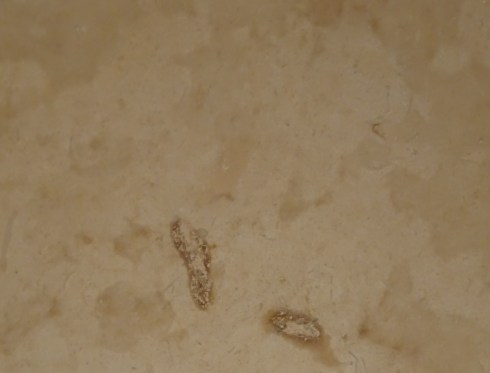The first night we arrive, Janet gives us a tour of the Colonial house where we will be living for the next three months. Janet points out the original “pasta” stone floors. Geometrically patterned stone is laid to appear as an elaborately colored rug in each room.
The effect is utilitarian and decorative. It reminds me of the mosaics we saw in the abandoned palazzi in Sicily…color and dimension encapsulated in a hard, polished stone surface.
When we come to the baño, Janet points out the stone sink. “This is carved by hand. The stone is accented with a dye made from a tea made from boiling tree bark. The dye has origins in Mayan culture,” she proudly explains.
The rock is obviously soft if it can be hand-carved, but what is it? I research the types of rock used in Merida’s present day renovations of the Yucatan’s Colonial homes. This is what I find.
“There are three basic kinds of stone, all of which are types of limestone, found locally and used extensively in building and decoration here and throughout Mexico. The softest stone is a white limestone called conchuela or coquina. It is marble-like in its appearance, often has tiny but visible sea shells in it and is quite porous. Because of that, it isn’t a good stone to use for counters or floors, but it makes great sculptures, wall sconces, wall molding, decorative columns, table-bases and frames. The other white stone is called macedonia and is quite a bit denser and harder. It polishes up nicely and is used in all the ways conchuela is used, but it can also be used in places like bathrooms and kitchens. The third stone is called Ticul stone, after the town near which it is found. The stone is orange or reddish in color, and can also be used in wet environments. It is dense and also polishes up nicely. These stones are also sometimes referred to collectively as cantera.”*
So these stone sinks and also the stone for the showers and all of the counters in the kitchen are probably “macedonia.” It shows the coquina’s bits of light and dark shell in the limestone.

If anyone knows more about stone tile floors decorated with pasta designs or stone used in decorative and functional structures in the Yucatan please expand or correct my information and tell us more about these beautiful substances.
*Yucatan Living:”The Stones of Dzitya”May 9, 207: Destinations, p.21. www.yucatanliving.com




Look forward to all your blogs about Merida, and all the Maya stuff around there! It will have to go on our Mexico bucket list! Still think about how nice it was to have lunch with you in Santa Fe last summer!
Hasta luego…
Barb and Ernie Werren
Hi Barb and Ernie,
This part of Mexico is fascinating. Very different from Guanajuato…climate foremost. We are just starting but excited about the months to come.
J&D, I remember as a child my first trip to St. Augustine, FL and the fascination I had for the massive Spanish fort there—Castillo de San Marcos—which protected the harbor. Later as an adult it still fascinates.. As you have discovered, this particular fort was built of quarried blocks of coquina. It is a testimony to its strength and durability that those blocks and the fort still look out to the sea centuries later. Your floors and fixtures are fabulous. Terry PS: We got more snow last night with three more rounds on the way!
Terry, Thanks so much for your interesting for story on your limestone experience. We had an old prison in Maui, Hawaii where my theater group met that was constructed of limestone. And in Virgin Gorda in the British Virgin Islands there are marine caves formed of karst (limestone) that are much like the “cenotes” here in the Yucatan. The filtered light is beautiful. There must be a correspondence between the climate and the geology.